Unfortunately, the Veterinary Medicines Directorate contacted me to tell me it was against the law to advertise this wormer since it was classed as ‘Prescription Only Medicine – Veterinarian, Pharmacist, Suitably Qualified Person (POM-VPS)’. and that ‘Products classed as POM-VPS can only be advertise in publications aimed at professional bodies and not to the general public’.
I was surprised they considered this page as advertising so I spoke to them and they advised me that I should not use the product’s brand name but could say ‘A product containing Flubendazole‘. As a result, I have removed the product name.
Before using medication to worm your chickens, it is best to check they need worming first by using a Worm Count Kit like this one. This is a simple test where a sample is sent off by post and the results are returned to you (usually by email) and will advise you whether or not you should worm your chickens.
In the United Kingdom, a product containing the anthelmintic (wormer) Flubendazole is currently the only licensed in feed product available for chickens. It is very effective at killing worms and their eggs. Worms can cause a huge amount of damage to chickens and cause many health problems. As a rule of thumb, if I have a sick bird, the first thing I consider is whether or not she was wormed recently before exploring other avenues because so many signs of illness can be as a result of worms.
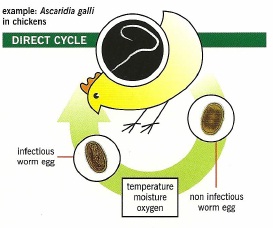
The Direct Life Cycle
Worms lay thousands of eggs in a day that are not always visible in droppings. Eggs then either get picked up by birds scratching around the floor, eating from the ground or in their litter when housed (i.e. picked up directly) or are eaten by earthworms or other ‘hosts’ and passed on to our birds when they themselves get eaten (i.e. indirectly picked up).
These two routes of infection are called the ‘Direct Life-cycle’ and the ‘Indirect Life-cycle’ and can be understood better from the diagrams show that are kindly supplied by Elanco (formerly Janssen Animal Health) where two examples of direct infection and one indirect are shown.
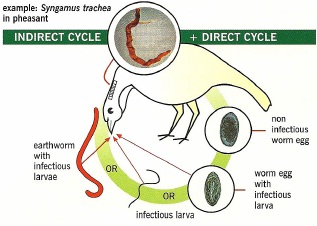
The Indirect Cycle
Worm eggs are destroyed by heat, drought, a hard frost and UV from direct sunlight. For this last reason, I keep grass short in runs over the hotter summer months where my hens graze so that worm eggs can be destroyed. Over the colder winter months or below 10 degrees Centigrade. Worm eggs cannot mature and therefore cannot become infectious so I test my hens with a worm count kit and worm if necessary in the Autumn as the temperature starts to drop and in the Spring when worms become active again.
This product containing Flubendazole that I’m not allowed to name is very effective and after the recommended 7 day treatment, chickens are free of worms and eggs. One thing to remember is that the thousands of eggs deposited via droppings (or coughed up in the case of Gape Worm) are still present in the environment so if the worm infestation is bad, you will need to repeat treatment after 3 weeks to break the cycle before the newly acquired worms (picked up from the eggs) have a chance to mature and lay eggs themselves.
The withdrawal period stated on the tub is nil for eggs from laying hens. This means that you can continue to eat eggs whilst your chickens are being wormed. I’m sure you won’t be eating your hens but they must not be slaughtered for human consumption during treatment. Treated birds may be slaughtered only after 7 days from the last treatment.
Where to buy
If you have a small flock, there is a 60g pack sufficient to treat around 20 large chickens. This comes with a handy little measuring scoop so that you can get the quantity right. One 6 g scoop treats 2 kg of food for chickens. This is the simplest way to worm and if you mix it as I suggest above with a little oil, you can be sure your chooks are getting the required amount. There is also a 240g tub or gamekeeper pack which is more suited to 50 birds or more and lasts longer.
Because of the tight regulations and a license that sellers need to hold (costing over £600 I was told by one company), both of these products are becoming harder and harder to buy. I bought a 60g tub in 1998 and paid £12.50. A year ago I bought another one and it was £70! Serious money.
The product containing Flubendazole can also be purchased pre-mixed in layers pellets on websites such as Amazon in 5 or 20Kg bags which is handy if you don’t want to mix it yourself.
I haven’t seen many places selling this product containing Flubendazole online and vets don’t usually stock it unless they specialise in poultry. The ‘regulations’ are pushing people to go to their vets or other suitably qualified people yet in fact if you chat to chicken keepers, they are being offered offer other large animal wormers containing Ivermectin instead that are often bought in large packs for use on farm animals. These haven’t been tested on chickens so you end up with vets advising anything from a 7 to 30 day withdrawal periods for eggs (depending on the view of the vet of what will be ‘safe’) and although this is perfectly legal, my personal opinion is that this is wrong when there is a tested product available.
How I mix this product containing Flubendazole
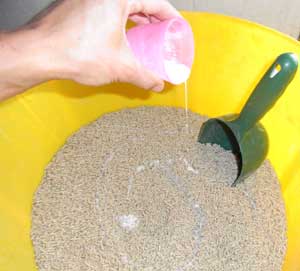
Adding the ‘paste’ to the layers pellets before mixing well
If you but the pack or tub then it will come as a powder that must be mixed with your chickens feed. In order to get this to stick to my layers pellets, I mix it in a small tub with a little Olive or Cod Liver Oil. The ‘paste’ that this makes can then be poured over the right amount of (weighed) pellets in a bucket and mixed well. It sticks to the pellets and won’t fall to the bottom of the bucket like I suspect some of the powder would without the oil.
Remember to wear disposable gloves for safety (yes I know we forgot in the photos!) and follow the ‘operator warnings’ given by the manufacturers below at the end of this page. Remember to dispose of empty containers in the domestic refuse. Used containers should not be recycled.
Pre-mixed layers pellets of course are easier and layers feed lasts for around 6-8 months before starting to spoil so you can use it for further treatments during this time.
How often do I worm my Chickens
As you will see from my routine list of jobs and from what I said above, I check my chickens for worms using a worm count kit twice per year as a preventative measure. Following the results, I worm if necessary but I also worm new birds that we add to our flock or if I become suspicious of worms / ill thrift.
I rotate the runs my birds use so there is no build up of worms. I would suggest you check for worms every 3 months if your birds are on the same ground continuously.
In between times, I sometimes use Verm-X and Apple Cider Vinegar to help keep worm numbers down as well as keeping the grass short in the summer months to allow UV from the sun to kill worm eggs.
You can read more about worms on my worming chickens page

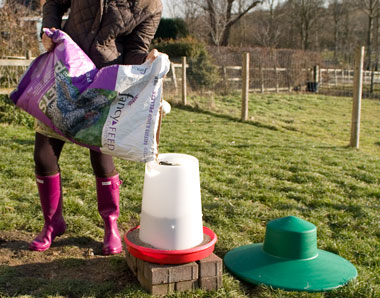
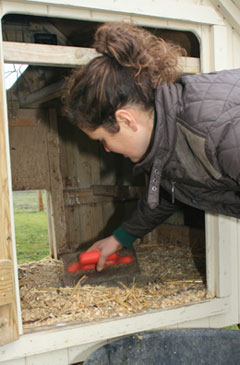
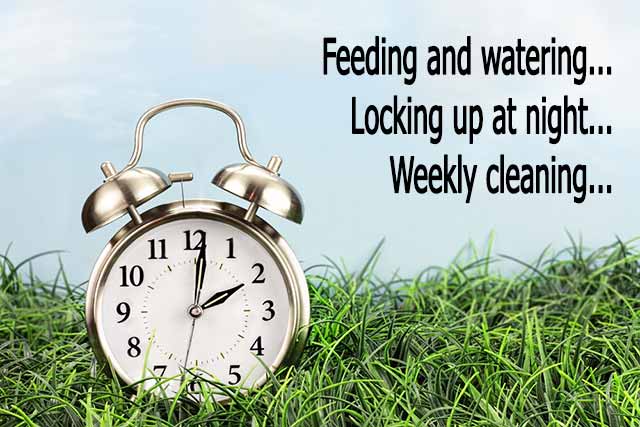
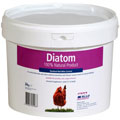
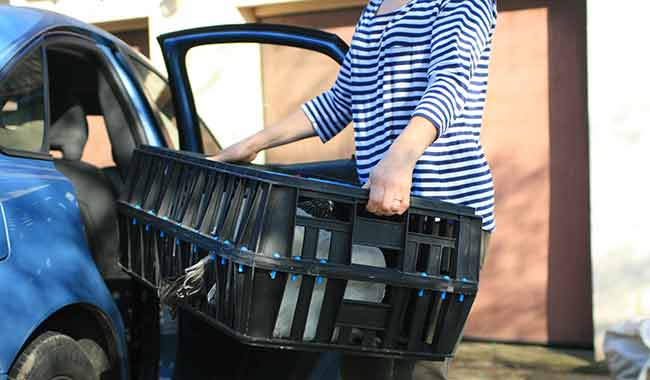
I have a Pekin bantam who is very ill and I suspect it may be gapeworm – she is drinking but refusing to eat anything at all – can I put Flubenvet in water, and if so, how much? The vet is coming to see her tomorrow but I really want to try and do something for her in the meantime.
No, Flubenvet is not supposed to be added to water, only feed.
I have heard of people adding a little Flubenvet to a half a grape for ill chickens but this is really a case of going to the vets for the best advice. It might be an injectable ivermectic would be better so that the correct diagnosis and dose can be administered.
Hi
I have to admit I am still confused about how much to give them in regards to Flubenvet!!
My flock of girls dont consume 2kg of pellets a day! Soooo…am I better mixing 500g of pellets with the reduced amount of Flubenvet and feeing it everyday OR can I mix the whole amount and they just get through it during the 7 days?
I was also thinking of mixing it as you suggested with olive oil but then putting it on their fresh corn teatime treat which they have everyday. At least this way they would definately get it every day for 7 days but I’m unsure as to how to work out the amounts?
Thanks
Carolyn
I mix the full amount I think I’m going to use in a soft bucket (shown in the photo) then top up my feeders with this feed through the week. You must exclude treats such as mixed corn to make sure they have the medicated feed.
You only need to mix up the amount you think you are going to use so you can mix half the Flubenvet with half the amount of feed, or quarter the amount of Flubenvet with quarter of the feed …. and so on.
I hope this helps..
Hi,
I’ve a mixed flock of chickens and runner ducks who I’m about to worm with flubenvet, I just wondered if there is an egg withdrawal period for ducks as I’ve read there is for geese and pheasants?
Thanks
Flubenvet isn’t licensed for ducks (although I use it and keep ducks and chickens together too) and therefore there is no information available about withdrawal periods.
Chickens have no egg withdrawal and you are right, geese have a 7 day withdrawal period.
Technically, you would need to go to your vet for advice about worming ducks… Victoria Roberts in her book Diseases of Free Range Poultry says to use Flubenvet and suspect worms for Waterfowl that go off their feet… I’ll leave it up to you to decide but I would be breaking the Veterinary Medicines Directorate (VMD) guidelines by suggesting you use a medication on anything other than the target species… A vet of course can use the Veterinary Medicines Cascade to prescribe an unlicensed medication if there is nothing else available. Most vets will use Panacur since they have this in stock although be warned, this only kills half of the worm species that effect poultry.
Hi.At what age can i start worming my chickens ?
7 of them are nearly 6 weeks and 1 is 4 weeks.
There is no ‘minimum age’ however they shouldn’t pick up worms until they are out on pasture and then it will take 3-4 weeks for the worms to mature into adults. I usually start just before egg laying age of 16 weeks or so.
hi, i have a chicken who’s looking rather down and so i’ve bought flubenvet as they haven’t been wormed in a year. I intend to treat all ten of my chickens but this individual, whom i presume is actually suffering, is not eating a huge amount and thus will not be taking in enough wormer to aid her recovery. Any advice on how i could resolve this? Thanks!
It’s good that you’re worming them. If you can’t get her to eat then she won’t last long and a trip to the vets is advisable, however even if she is eating just a little, the Flubenvet will still kill a lot, if not all worms.
If worms are the problem and the gut is impacted (blocked with worms) then she will not eat much and worming them / killing all of the worms can release toxins into the body that will kill her. It’s better to let her eat what she wants and then as she recovers, in 3 to 4 weeks, worm again.
It might not be worms of course – one thing you can do (not very nice sorry) is put a sample into a jam jar with water, close the lid and shake it. Look carefully for worms. Most of the common worms can be seen with the naked eye if you have good eyesight and look carefully.